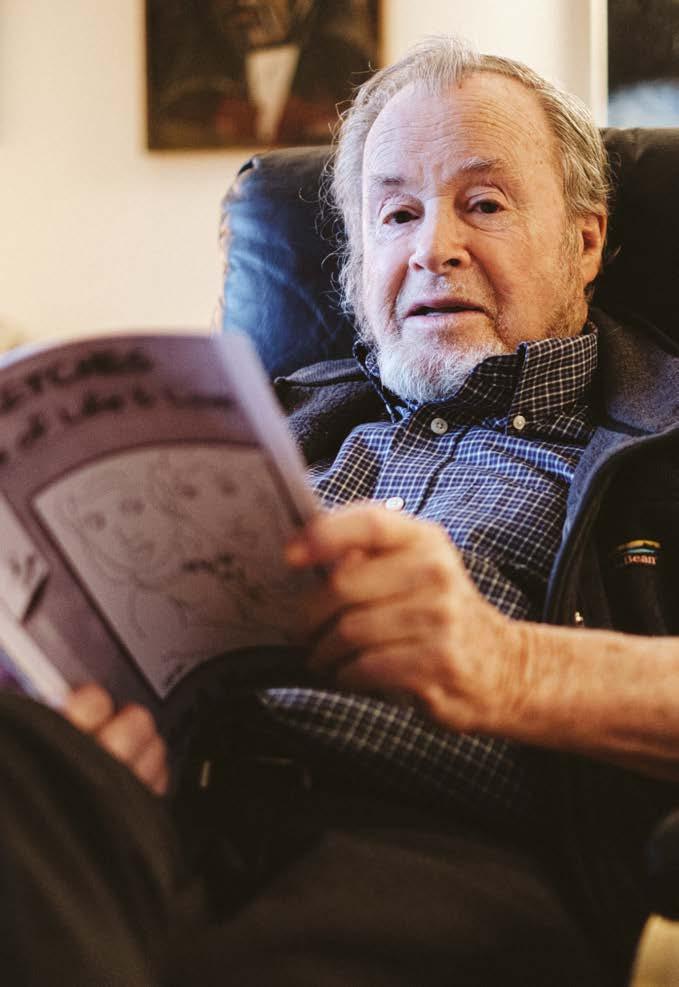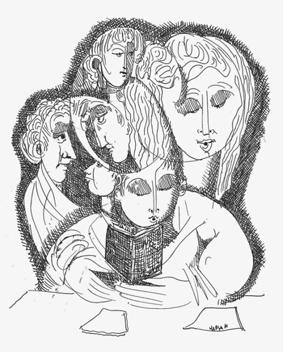
5 minute read
The Works: Saul Kaplan faces it in a new book.
CONTINUED FROM PAGE 19
Saturday 3/26
Advertisement
classes
Book Arts Workshop: Western Marbling with acrylic paint with Sandie Brayman.
This western marbling workshop will guide participants through the process of marbling successively more intricate patterns. $120140, 10am. Virginia Center for the Book, Jefferson School City Center, 233 Fourth St. NW. vabookcenter.org
outside
Charlottesville Ten Miler. Runners will traverse through UVA Grounds, downtown, and more. $60, 7:15am. John Paul Jones Arena, 295 Massie Rd. cvilletenmiler.com IX Farmer’s Market. Over 60 local vendors with fresh produce, prepared foods, artisan goods, and more. Free, 9am. IX Art Park, 522 Second St. SE. ixartpark.org
etc.
Harry Potter and the Deathly Hallows:
Part 1. Part one of the epic finale. $10, noon. Alamo Drafthouse Cinema, 5th Street Station. drafthouse.com Met Live in HD: Don Carlos. For the first time in company history, the Met presents the original five-act French version of Verdi’s epic opera of doomed love among royalty, set against the backdrop of the Spanish Inquisition. $1825, noon. The Paramount Theater, 215 E. Main St., Downtown Mall. theparamount.net Nausicaä of the Valley of the Wind. Presented in Japanese with English subtitles. $10, 1pm. Alamo Drafthouse Cinema, 5th Street Station. drafthouse.com
Paramount Presents: Learning to Live Together–The Return of Mad Dogs & En-
glishmen. An electrifying documentary and concert film spotlighting the reunion of the celebrated Mad Dogs & Englishmen, Joe Cocker’s short-lived tour featuring a mammoth thirty-two-piece band. $12-15, 7:30pm. The Paramount Theater, 215 E. Main St., Downtown Mall. theparamount.net
Sunday 3/27
music
Brunch with Sammy. Enjoy brunch with Sammy Horn on piano. Free, 10am. The Pub at Lake Monticello, 51 Bunker Blvd., Palmyra. lakemonticellogolf.org The Wavelength Trio. Jazzy-blues. Free, 2pm. Glass House Winery, 5898 Free Union Rd., Free Union. glasshousewinery.com
UVA Chamber Music Series—Concert 5.
Featuring UVA faculty and guest artists. Free$15, 3:30pm. Old Cabell Hall, UVA Grounds. virginia.edu Vincent Zorn. Enjoy brunch with live music. Free, noon. South and Central Latin Grill, Dairy Market. southandcentralgrill.com
Zachary Williams of the Lone Bellow with
Early James. The Dirty Camaro Tour. $18-22, 8:30pm. The Southern Café & Music Hall, 103 S. First St. thesoutherncville.com
dance
Salsa Class. Learn to salsa and strut your stuff. $6-8, 7pm. IX Art Park, 522 Second St. SE. ixartpark.org
stage
The Legend of Georgia McBride. See listing for Wednesday, March 23. $25-30, 2pm. Live Arts, 123 E. Water St. livearts.org
Figuring it out
Saul Kaplan sees unity in a thousand faces
By Matt Dhillon
arts@c-ville.com
In February, Saul Kaplan marked both his 93rd birthday and the release of a new book of artwork. The self-published Sketches: Faces of Life & Love highlights what is perhaps the artist’s most discreet and most intimate medium, his drawings.
Having retired to an apartment in Martha Jefferson House, the ceramics and painting that were the priority of Kaplan’s artistic career became more difficult. But Kaplan cannot sit down with a pen without coming away with a drawing. It’s a habit he’s developed from over 60 years of practicing.
“Drawing is a muscle memory, eye muscle coordination,” Kaplan says. The memory that keeps returning to the muscles of his fingers, wrist, and arm is the memory of human faces.
Over the years, Kaplan has drawn thousands of human faces, and on every page his book is populated with that most familiar of images.
“The human face expresses everything,” he says.
Kaplan’s simple lines craft expressions on the shifting array of faces, digging for the bare-bones of emotion buried there. We see eyes meet, or downcast, or slitted, eyes tired, or gentle, or cunning. Lips are curled, puckered, pouting, or tense. Noses sharp and soft, cheeks broad and narrow.
Perhaps it is this simplicity of bare lines that makes drawing, as Kaplan says in the book’s prologue, “the most intimate and direct form of visual communication.” While intricacy serves to expand and amplify, the simplicity of the line drawings in Faces of Life & Love go in the opposite direction, seeking to distill the essence of an eyebrow, or a lip, and identify the essential lines that carry emotion. In the most minimalist renderings, Kaplan refines a somber face into just a handful of lines.
Kaplan also alludes to ancient Egyptian drawings. “The style of the Egyptian eye has been repeated over history,” he writes. “The eye I draw, like Picasso did, had its beginning in Egypt.”
That eye—drawn over and over for centuries—mirrors Kaplan’s endless creation of faces throughout the years. In this obsessive repetition and focus on the geometry of shape, Kaplan’s drawings search for something basic about the human face, its composition, and its familiarity. As the Egyptians did, Kaplan attempts to use the very specific and precise lines of a face to strike a resounding chord.
In this collection, we see the warm human population that Kaplan has created as a result of that repetition. Most of them are not alone, drawings occupied by two or more figures in
EZE AMOS
COURTESY OF THE ARTIST

Saul Kaplan began his professional artmaking in 1948 at the prestigious Hans Hofmann School of Fine Arts, where he studied drawing under Hofmann, who was a contemporary of Henri Matisse. Kaplan released his third book, Sketches: Faces of Life & Love, just before his 93rd birthday. some form of relationship to each other. Often, their bodies overlap or blend so that we see two faces that share one eye, or three heads that share one torso. In these fusions there is a sense of togetherness, of something shared that merges the characters in a visceral way.
Each drawing, he says, is a kind of personal signature. “[As artists] we are making our mark some way or another. It’s a kind of waving and saying, ‘I’m here.’”
Kaplan, like his characters, tries to merge with something bigger than himself, participating in the collective story. “That’s what an artist really does,” Kaplan says. “He tries to use the medium he’s in to express something—it could be anything—but it is now part of history, a part of mankind.”
In the same way that the thousands of Egyptian eyes are actually one eye, iterations of the same form, Kaplan’s endless faces resolve into one face, waving at the world.




